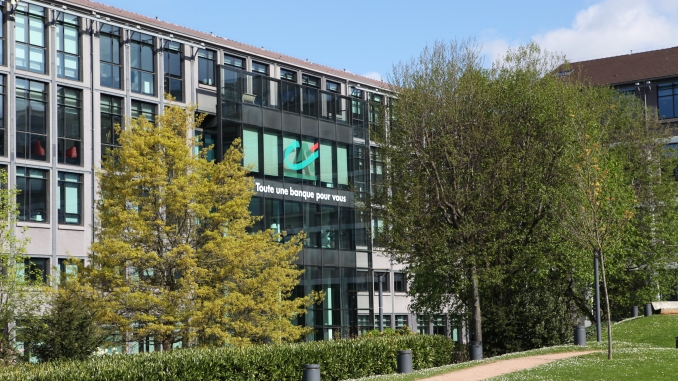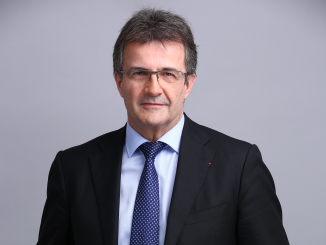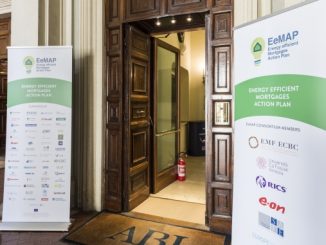
A debut EUR1bn green bond for Crédit Agricole SA attracted over EUR1.5bn of demand on Wednesday, and a syndicate official at the French bank argued that, by achieving a lower new issue premium than conventional comparables in challenging markets, the senior preferred deal offered support for the existence of a “greenium”.
The French group unveiled its green bond issuance plan on 21 November and followed up with a roadshow across Europe from 23 November, stating that a fixed rate intermediate maturity senior preferred bond could follow.
Sole green structuring advisor and sole bookrunner Crédit Agricole CIB opened books for the Crédit Agricole SA issue on 28 November, venturing into markets that had been hit by volatility and where many investors were either staying on the sidelines or sticking to defensive instruments.
The French bank went out with initial price thoughts (IPTs) of the mid-swaps plus 65bp area for a benchmark-sized five year issue, rated A1/A+/A+. Books were above EUR1bn in less than two hours and above EUR1.4bn, with over 90 accounts involved, after a little over three hours, when guidance was set at 55bp-60bp over and the size at EUR1bn. Half an hour later the books were closed and pricing set at 55bp over.
Vincent Hoarau, head of FI syndicate at Crédit Agricole CIB, said the pricing incorporated a new issue premium of around 12bp, less than the 15bp-25bp that comparable senior preferred and HoldCo supply had paid in the preceding week, even in shorter maturities.
“I believe CASA suggests that a ‘greenium’ does exist,” he said, “even if it is limited to 2bp-3bp for core names with strong ratings in these markets. Although the underlying risk and other parameters are the same, there is a growing imbalance in the green demand/supply dynamic due to the massive pressure the buy-side is under to invest in green or sustainable assets.
“In the primary market we see greater traction among investors for green bonds because they are less price-sensitive, being ready to give ground to get the green element. They also anticipate better secondary market performance, with green bonds tending to be smaller and placed in safe hands, while traders will short conventional bonds before going short a small green bond.”
Hoarau noted that there was less movement between IPTs and final pricing than on some issues by design, saying that investors have been irritated by large movements in pricing.
“We started closer to where we thought the bonds belonged,” he said, “i.e. less NIP to start with, but also less tightening, showing greater sensitivity to investors’ requests, while the issuer ultimately achieved a more competitive outcome than peers.”
Ninety-three investors were in the book. Asset managers were allocated 58% of the bonds, insurance companies and pension funds 17%, ALMs 15%, central banks and official institutions 9%, and hedge funds 1%. France took 31%, the Benelux 23%, Germany and Austria 21%, the UK and Ireland 14%, southern Europe 4%, the Nordics 3%, Asia 3%, and others 1%.
Philippe Brassac, Crédit Agricole SA CEO (pictured), said the size, nature and granularity of the bond is likely to make it “a benchmark operation in the banking landscape”.
 “The economy and finance can and should become powerful allies in order to achieve the objective of carbon neutrality by 2050 as set out in France’s Climate Plan,” said Brassac. “This green bond issuance will enable us to forge ahead with our commitments.”
“The economy and finance can and should become powerful allies in order to achieve the objective of carbon neutrality by 2050 as set out in France’s Climate Plan,” said Brassac. “This green bond issuance will enable us to forge ahead with our commitments.”
Although Crédit Agricole CIB has been a prominent arranger of green bonds and has privately placed its own green bonds, Crédit Agricole SA (CASA) had not yet issued a green bond. Indeed, given the cooperative nature and structure of the Crédit Agricole group, under the new green bond framework CASA is issuing the green bonds but the proceeds are used to refinance assets booked by group members including the Crédit Agricole Regional Banks (24% of the green bond portfolio), Crédit Agricole CIB (71%), LCL (2%) and Crédit Agricole Leasing & Factoring (3%).
Renewable energy comprises 56% of the green portfolio and is prominent among Crédit Agricole’s wider sustainability goals: in 2016 it was the leading banking group financing renewable energy in France, with 27GW of renewable energy installed worldwide, according to the bank, and it by the end of 2019 it aims to finance one-third of France’s renewable energy and energy efficiency projects, and in the process double the level of renewable energy financing in France.
Eligible projects categories also include: green buildings; energy efficiency; clean transportation; waste and water management; and sustainable agriculture and forest management.
The green bond framework has a second party opinion from Vigeo Eiris, which confirmed alignment with the Green Bond Principles. Vigeo Eiris noted that Crédit Agricole displays an overall “advanced” ESG performance, ranking third in its “Diversified Banks Europe” sector, which covers 31 banks.
Main photo: Campus Evergreen, seat of Crédit Agricole, Montrouge; Credit: Xavier Isaac/Crédit Agricole



